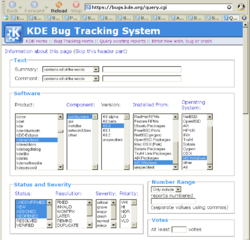Projects/KDE on Windows/How to Help
Testing
More you use the software, more issues and wishes you can find. Do not keep this knowledge for you - file a bug on http://bugs.kde.org, the KDE Bug Tracking System (Bugzilla).
Querying existing reports

To find a report use the Query Reports form, where you can specify product, component, version, installation type and operating system, and a few more. To find Windows-related reports, select one or more parameters of your search (what can make your result set more or less limited):
- Product: for installer select kde-windows; for applications, find appropriate name, e.g. amarok
- Component: options depend here on the selected product; e.g. for installer there are the following components:
- buildsystem - The build system for KDE on Windows: plain cmake and emerge
- gui - GUI-related issues for KDE on Windows
- installer - A graphical Installer for binary KDE packages (components and applications)
- network&files - Network and file-handling -related issues for KDE on Windows
- other - Other issues for KDE on Windows
- Version: depends on the selected product; for installer it can be 4.0.0, etc. (you can check version in the "Help->About" dialog window of any application)
- Installed from:
- MS Windows - means that the source was the installer for Windows
- Compiled Sources - means you have compiled your binaries using emerge facility
- Operating system: MS Windows
You can click with Ctrl key pressed to make multiple choices in a list.
Sending a new report
To send a new report:
- create new account (if you do not have one yet); note than your account will be assigned to your email address, which will then be available in the public
- login
- go to the KDE Bug Report Wizard and read information provided here if you are new to the bug tracking system
- click "Continue" button and select the KDE Version (most probably 4.x) and the Distribution Method - "MS Windows Binaries", the very last item on the list.
- click "Continue" button and enter a component name into the Find field, press Search button and select one of the items from the Application list. "Application" means "Product" here.
- Fill the "Application Version" field and click "Continue"
- Enter the summary, select "MS Windows" as the operating system
- "Check for Duplicate Bug Reports" page appears; you have a chance to find already reported similar bugs; press "Continue" button if there is no similar report
- Fill "Severity" field and provide appropriate amount of information in the "Bug Description" box, then click "Finish"
Notes
- Before reporting make sure that you are not going to duplicate already existing report.
- Each report has its own unique number and web page. You can correct the information you have provided in the report afterwards, e.g. fill in a product version.
- If you discover that a bug or a wish is not directly related to MS Windows (e.g. a bug can be reproduced on more or all operating systems), set the "operating system" field to "All" and the "platform" field to "unspecified".
- Do not use this KDE TechBase wiki site to report bugs. Use bugs.kde.org.
Development
Please read general information and Preferred skills for starting KDE Development.
You can join the development team! Please start by exploring this TechBase web site, especially the KDE on Windows Development section.
See also
- FAQs
- KDE Development FAQs
- Bugsquad
- The Bugsquad Team tries to keep track of bugs in KDE software and make sure that valid bugs are noticed by developers.
- KDE Quality Team
- The task of the KDE Quality Team is to detect the loose ends in an application, and try to tie them together.
